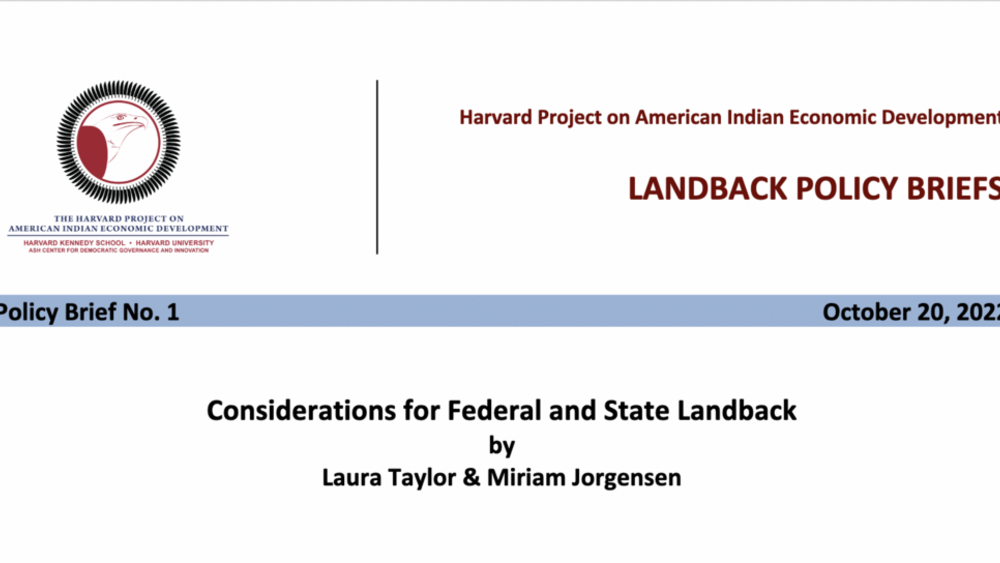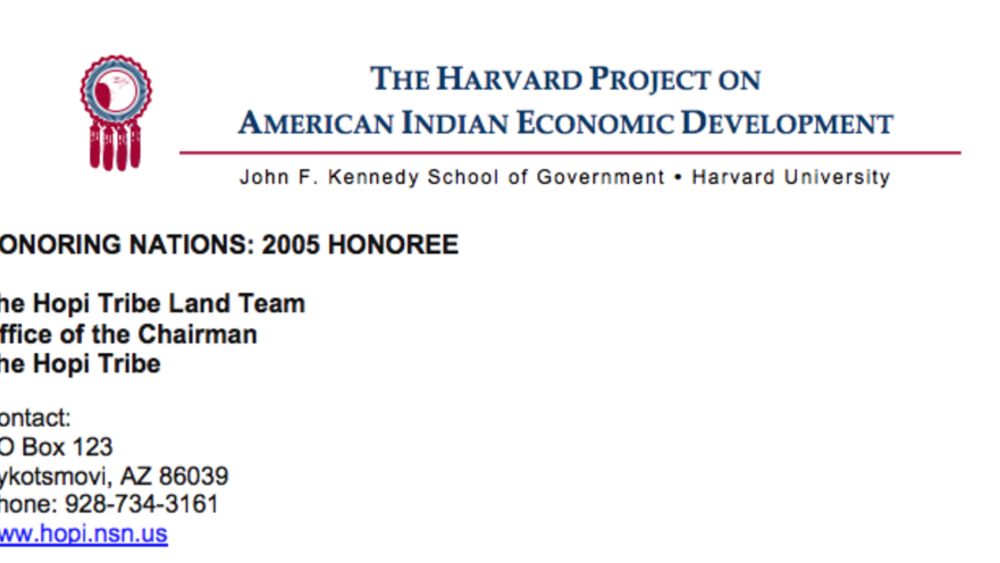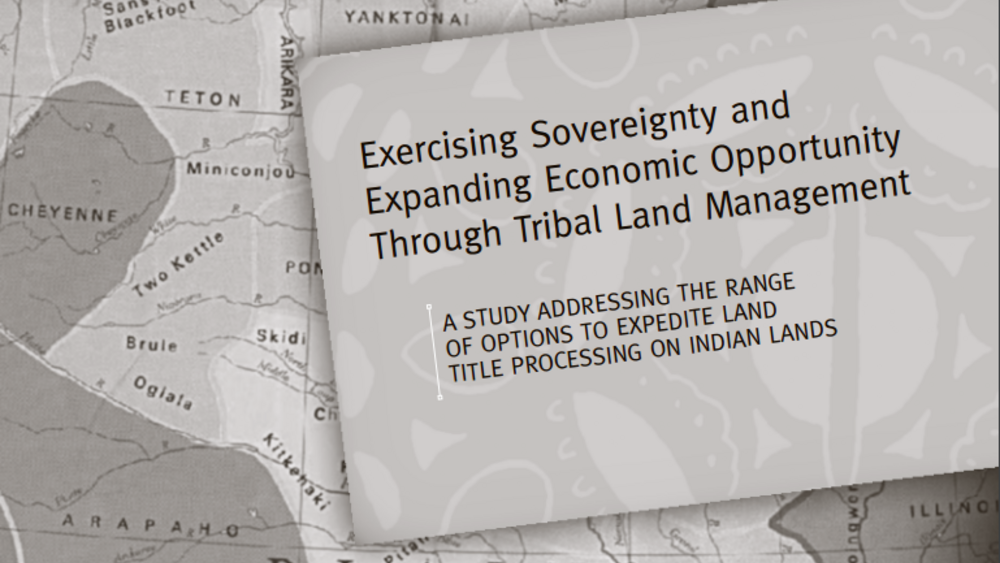Former Chairman of the Hopi Land Team Cedric Kuwaninvaya presents an overview of the tribal subcommittee's work to the Honoring Nations Board of Governors in conjunction with the 2005 Honoring Nations Awards.
Additional Information
Kuwaninvaya, Cedric. "The Hopi Land Team." Honoring Nations Awards event. Harvard Project on American Indian Economic Development, John F. Kennedy School of Government, Harvard University. Tulsa, Oklahoma. November 1, 2005. Presentation.
Transcript
Cedric Kuwaninvaya:
"[Hopi language]. Greetings from the Hopi Tribe to the Honoring Nations Advisory Board and honored guests. It is with great honor and privilege to deliver our final presentation to you. The Hopi Land Team is a subcommittee of the Hopi Tribal Council and has delegated authority to develop land policy, to explore and administer the best and most favorable uses of our natural and water resources and to seek and purchase viable business and land opportunities. I would like to recognize the current Hopi Land Team members: Ms. Marilyn Masayesva from the village of Bacavi who's our Vice Chair, Denny Humetewa from the upper village of Moenkopi, Jack Harding, Jr. from the village of Kykotsmovi, John Polela from the village of First Mesa, Leon Carew from the village of Mishongovi, and Wayne Taylor, Jr. who is the Chairman of the Hopi Tribe. My name is Cedric Kuwaninvaya. I am from the great village of Sipaulovi and the Chairman for the Land Team here.
A fundamental principle consistently exercised by the Hopi Tribal Council is our innate responsibility to preserving our homeland as an act of inherent sovereignty. As the original inhabitants of the isolated desert terrain of our aboriginal lands in the Southwest, the Hopi Land Team has focused its efforts on the restoration of our aboriginal lands, to restore free access to shrines, culture and religious sites balanced with contemporary goals of economic development and tribal self-sufficiency. The Hopi Tribe will soon be transferring up to 420,264 acres of acquired lands into trust. Since the passage of the Hopi-Navajo Land Settlement Act in 1996, much thought and planning has taken place to select fee, state and U.S. Forest, BLM lands that lie within our aboriginal lands. Although these lands do not encompass the original extent of our aboriginal lands, the acquisition of these lands symbolically replenish lost lands and more importantly regain our inherent land stewardship responsibility handed down since time immemorial. Moreover, these acts of the Hopi Tribe strategically lay the path to search new opportunities for economic development and to build a promising future for the Hopi people.
The purchase of lands is balanced with the purchases of business concerns such as commercial retail properties, a cattle-ranching business providing a product to the premium beef market, a bed-and-breakfast business, and a full truck stop serving the traveling public and commercial fleets off Interstate 40. Since the year 1998, these businesses have returned approximately three million dollars in profits to the general fund of the Hopi Tribe, which comprise approximately two percent of the annual general fund budget each year. The funds are then allocated to the Hopi villages for village projects such as elder and youth programs and to the Hopi tribal government for its operations. A comprehensive land management plan will govern the development of the newly acquired lands. The resources on these lands include hunting, fishing, boating, cattle grazing leases, recreation, power line rights of ways, management of cultural sites, a utility-scale wind energy farm and a potential utility-scale solar energy farm. These new economic development opportunities will generate revenue, create jobs, and enhance the portfolio of the Hopi Tribe.
The long-term goals of the Hopi Tribe and the plans to manage the development of the newly acquired lands and business concerns will be overseen by the Hopi Economic Development Corporation, a chartered corporation. In addition, our Wildlife Endowment Fund will provide the core funding for wildlife management on all Hopi lands. More importantly, as the picture shows, the most significant opportunity is the strengthening of the Hopi Tribe's ability to continue the practice of long-held religious, cultural and traditional practices. As the lands acquired formally aboriginal lands include eagle shrines, cultural sites, sacred trails, access to herbs, plants and wildlife used in our religious ceremonies. The future of the Hopi rests on its resources. Therefore the Land Team drives forward the concept that land is the foundation for Hopi beliefs and values and in the modern context an investment in the future. The growth and stability of the Hopi people rests on the proper activities of the Hopi tribal government and the Land Team serving as the enforcer for the tribe's responsibilities and vision. We remain committed to preserving our homeland and stand strong on the principle of preserving the good things of Hopi life and dealing with the modern problems with the United States government and with the outside world. [Hopi language]."
Alfreda Mitre:
"First of all, I want to say I'm very jealous of the Hopi Tribe's exclusive right to identify and select and purchase land and then have that land transferred into a trust status. Not many tribes have that opportunity. As a tribe, a small tribe in Nevada, we struggle very hard to acquire our traditional lands back so I want to first of all congratulate the Hopi Tribe and the team here for all of their work. Out in...throughout the United States you have tribes that are purchasing back their homelands and often are accused of ‘reservation shopping,' looking for convenient locations for economic development. Could you elaborate a little bit on how the selection of lands to be purchased or acquired are made?"
Cedric Kuwaninvaya:
"In Hopi, our elders have always told us where our lands had extended previously into the four western states and so with that knowledge when we were having a dispute with our neighboring tribe there, we had this dispute for over 100 years, and how we got acquisition of our lands back, we went to court and fought over this trying to get our aboriginal lands back. So through a congressional act we acquired...the Congress allowed us to get up to 500,000 acres that we could put into trust. So through the congressional mandate, that's what happened with our tribe. And once when we were given the authority to go out buying land, we looked at the land, what was on the land -- including water rights -- because we needed water to survive and look at that in terms of putting an investment into the future for our young people."
Alfreda Mitre:
"The next part of the question is, given that there aren't too many tribes that have the same opportunity that the Hopi's have, what advice would you have to tribes in terms, should this opportunity become available to them, what advice do you have for them?"
Cedric Kuwaninvaya:
"I guess the advice I have for them is make sure you know your culture, your traditions because everything hinges on that and the places where you're going to identify that maybe once identified to your people. Be aggressive, pursue it because we all know that the federal government took our lands away and because of treaties or other tribes that are under the IRS or IRA [Indian Reorganization Act], they owe us a lot so I would advise that the people in the tribes pursue it aggressively."
Elsie Meeks:
"I have a question for you. Congratulations on being one of the finalists and for the work you've done. What do you see as the next phase in this process? What are your next goals? Is it more land purchase, is it trying to get businesses profitable or what..."
Cedric Kuwaninvaya:
"Right now, we have a limit of acquiring up to 500,000 acres to put into trust so we're still going to be looking for lands cause it's still available to us. The other part is also looking at economic opportunities. Right now we have established an economic development corporation and all of the purchases that we've made will transition into that corporation, so they're the experts at doing business so that part will be transitioned. The other part is, yes, a lot of education needs to be done at our local level because all of these years we've had our lands taken away and the Hopi people have been stretched out, put a lot of money into trying to get our lands back, a lot of time and effort has been put into that. Now they need to feel relaxed and there needs to be a lot of educating at the local village level whereby we tell them, ‘Yes, we are gaining our aboriginal lands back and you can make use of it of how you made uses of them before, a long time ago.' There's still a lot of challenges and opportunities out there for the Hopi people."
Oren Lyons:
"The land dispute between Navajo and Hopi is an old one. What was it that made the breakthrough to work together? How did you do that?"
Cedric Kuwaninvaya:
"There's one that's called the 1882 Land Case. That one we went to Congress to settle. Then there's another one that's called the 1934 Case. That one has been in court for a lot of years, but I think what the tribes decided to do was rather than having the court settle it because the courts don't know how we live on Hopi, how the Navajos live their lives. We came together with the Navajo Tribe and said, ‘This is our land, these are our people, we know what's going on with our lives. We don't want the federal government or the courts to settle this.' So we came together and we...what happened from that was we had a compact on the different areas where the tribe goes into the other tribe's lands to get herbs or do religious activities there. So that's how this one came about and right now the Hopi Tribe has approved the 1934 compact and it's before the Navajo tribal council. So if they approve it then that's the end of our land disputes that we have."
David Gipp:
"Where is the bed-and-breakfast ranch that John Wayne used to own?"
Cedric Kuwaninvaya:
"That's located in Eager, by Springerville in Arizona. I understand John Wayne turned several times in his grave when he heard that the Indians had conquered his ranch."



